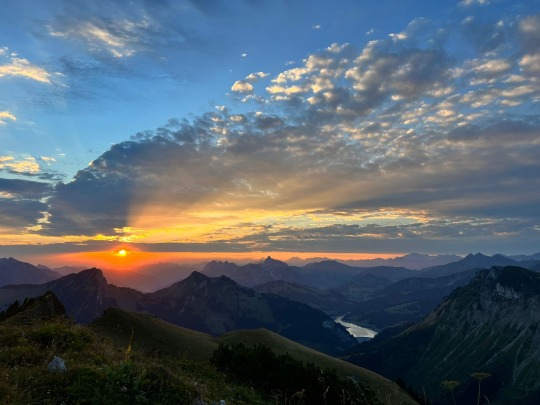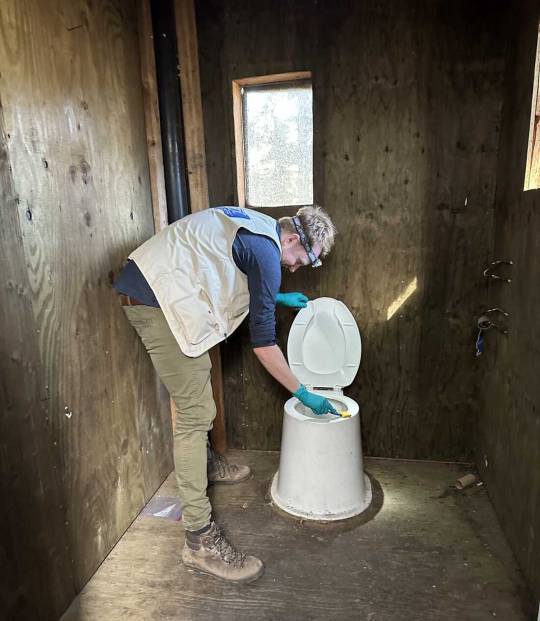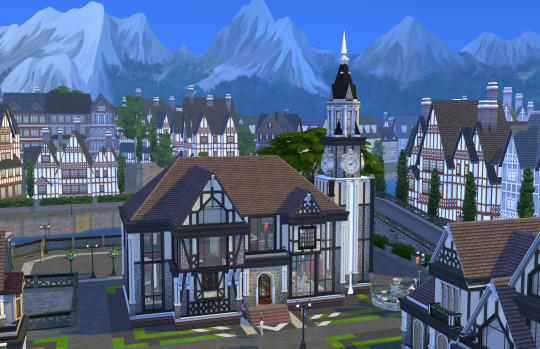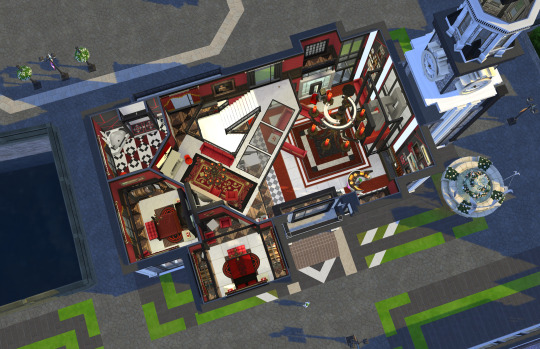#club alpin
Text

Club Alpino Espanol
35 notes
·
View notes
Text

The mountains are my safe place
#my post#mountain#photography#sunrise#landscape#switzerland#mountains#Vaud#swiss alps#club alpin suisse#nature hikes#hike#granola girl#nature
15 notes
·
View notes
Text
Norovirus on the PCT . . . How an outbreak spreads along the trail
September 24
By Pien Huang for NPR
I was just corresponding with another PCT-hiking friend about the few times we have felt unsafe on the trail. All of our examples related, not to bears or rattlesnakes or even lightning (I might have included lightning had I thought about it more), to human encounters. A lost soul or two on the trail, hunters combining alcohol and firearms, a camping area near a road. Now here is another thing to worry about . . . norovirus. It is a good reminder not to abandon hygiene in the wilderness. RH

EIS officer Arran Hamlet walks into the Government Meadows site to conduct environmental sampling for norovirus.
Last September, Kevin Quinn was trekking through a remote, mountainous region in central Washington state, when he started feeling sick. "At first, I thought it was just a stomachache," he says, "But when we got to the campsite I started throwing up, and it started coming out the other end as well."
Quinn was on the trail with his daughter, who had left her job so they could hike together. After months of hiking, he found himself wiped out at a campsite in the middle of nowhere.
"I had heard about the norovirus for years, but it was always in the context of 'Oh, there's a cruise ship in the Caribbean,'" he says, "You don't think about this being an issue when you're out on the Pacific Crest Trail."
Norovirus is a highly contagious virus that can cause serious gastrointestinal distress for several days. It's often associated with enclosed, crowded settings like cruise ships, health care facilities and childcare centers.
But it also crops up in the wilderness – like in an outbreak among hikers like Quinn last year which was documented in a recent investigation by the Centers for Disease Control and Prevention.
Call in the disease detectives
After a stream of sick Pacific Crest Trail hikers came through the Washington Alpine Club Lodge near Snoqualmie Pass last summer, a volunteer named Robert Henry closed the dorm-style lodge and emailed health authorities.
"My concern at the time was to make sure that the hikers on the trail didn't get any worse, and to make sure that the volunteers at the Washington Alpine Club didn't contract whatever it was they were bringing in," Henry ways. He also worked to warn other hikers about the threat.

EIS officer Dr. Arran Hamlet observes a water source being tested for environmental contamination of fecal waste and norovirus.
Hamlet focused on a 70-mile stretch of trail south of the Lodge, where ill hikers were coming from. One common rest stop, he learned, was a remote log cabin in the meadows, with a pit latrine and a stream that's used for drinking water.
Hamlet and his team hiked out to the cabin and tested water from the stream. They also swabbed the toilets, the door handles, the tabletops, the poker chips – anything people were touching. While the water samples came back clean, "every single [surface] swab tested positive for fecal contamination," he says.
"This doesn't mean that we can see human feces on things," he adds, "but at some point in time, there was transmission of human fecal contamination onto every surface in the cabin we swabbed, and also everywhere in the latrine."
The results of the investigation were published this month in the CDC's Morbidity and Mortality Weekly Report. Investigators concluded that there was an outbreak of norovirus on the trail last summer that was spreading between hikers and that "exposure to contaminated surfaces within the cabin and ... latrines likely amplified transmission."

EIS officer Dr. Arran Hamlet swabs a backcountry pit latrine for norovirus sampling during an investigation for an outbreak of gastrointestinal illness among Pacific Crest Trail Hikers in 2022.
Shanna Miko, a nurse epidemiologist at CDC, was part of the field team on the Pacific Crest Trail study — and it wasn't her first norovirus-in-the-woods investigation. Last year, she traced an outbreak at the Grand Canyon, among people who were backcountry hiking and whitewater rafting.
"These are very well-planned trips. For many people, they're once-in-a-lifetime," she says. Travelers often read books and blogs in preparation, and get advice from others who have done the trip before them, accumulating trail wisdom – "places where people frequently stop, or places that have shelters where people frequently sleep over," good places to get water, or use the bathroom, she says.
These hubs, which seem so remote, see thousands of people – in varying levels of wellness – pass through in a season. They may not leave visible traces but some may leave germs, like norovirus, that can live on environmental surfaces for a long time, Miko says. (According to the CDC, this hardy virus can stay alive on surfaces for "days or weeks.")
Hand sanitizer doesn't cut and other advice for staying well
With norovirus, hand sanitizer and common water filters don't work. The virus is small, and "extra sticky" on skin, Miko says. And it takes just a few dozen viral particles to make a person very ill.
Miko says there are ways that hikers can cut their risks.
Always wash your hands with soap and water after you have a bowel movement – and wash them again before you eat. "The soap is a great detergent to remove the virus from your hands," she says. While any soap and water will work, she recommends biodegradable soaps in protected national parks and backcountry woods to reduce the impact on the environment.
Make sure to drink and cook with good, clean water. Pay attention to where the water comes from, and treat it properly. "Boiling for at least three minutes is the best way to kill everything you would typically come across," Miko says. And note: Most water filters are good at removing bacteria and common parasites but they don't cut it when it comes to norovirus. You'll need to layer on either chemical treatment or UV light treatment to kill the virus. (Here's the CDC's breakdown of what works for which pathogens.)
If you do fall ill, shelter in place if you can. This is for your own safety, and for the sake of others, "so you aren't seeding norovirus particles along the trail and putting others at risk," Miko says. This is not the time to try to push ahead but to rest and hydrate. "If possible, try to keep your defecation far from the trail and bury it, and don't prepare food anywhere near where you're using the restroom or vomiting," she says.
The worst of the symptoms usually passes in two to three days, though "you can still spread norovirus after you feel better," Miko says. She recommends waiting at least two days after symptoms have resolved before continuing on.
Norovirus was the last straw

Kevin Quinn set out to hike the Pacific Crest Trail with his daughter, Katie, who had left her job so they could hike together. Norovirus derailed their plans.
He was thirsty, he was really tired – and while he filtered the water, he skipped the additional, chemical treatment. Soon, he knew he'd made a mistake. "I was completely debilitated. I didn't have the energy to set my tent up," he recalls, "All I was doing was, like, every 15 minutes, going off into the woods and either throwing up or having diarrhea."
After a night of being very ill, Quinn and his daughter made a long, slow trek out of the woods. "We never made the whole trail," he says, "We just decided to call it quits."
Earlier in the summer, he caught COVID, which derailed his trail plans for a month. Up ahead, there were wildfires and trail closures. For Quinn, getting norovirus was the last straw.
A year later, he still regrets that he didn't take the time to treat the water properly.
To other hikers – he says: heed the signs, wash your hands and make sure your water is clean. In his experience, it's not worth the risk.
And, we would add, that water treatment options like the Steripen (using UV technology), would seem to be more effective.
9 notes
·
View notes
Text
F1 Book Club









Nobody get offended - just having a little fun. 😉
#f1 book club#f1 memes#ferrari#scuderia ferrari#alpha tauri#alfa romeo#williams#williams racing#rbr#red bull#mclaren#aston martin#alpine#mercedes#f1#formula 1#formula one#haas f1 team#haas
38 notes
·
View notes
Text

Alpine Club on the 1900 Paris World Exhibition
French vintage postcard
#historic#club#photo#briefkaart#vintage#exhibition#sepia#alpine club#photography#carte postale#paris#postcard#postkarte#postal#tarjeta#ansichtskarte#french#old#ephemera#postkaart#world#paris world exhibition#alpine
5 notes
·
View notes
Text
today is NOT a good day for the french
#esteban dnf and pierre getting bullied by the astons#im not gonna be surprised if they have another loser club#esteban ocon#pierre gasly#alpine#british gp 2023#update: and pierre dnf too :(
7 notes
·
View notes
Text

American Alpine club members mingle with Canadian Alpine club members.
Rogers Pass, British Columbia
1908
#vintage camping#campfire light#beautiful british columbia#history#camping#rogers pass#alpine clubs#exploring
92 notes
·
View notes
Text
believing the spanish sport press about random rumours? couldn't be me.
#am i talking about f egy or footie? lmao both#but to the current nonsense:#there is no way in hell that arteta is leaving the club#but also people who take alpine especially esteban related rumours seriously from spanish juornos are so funny
4 notes
·
View notes
Text
im highly confused at my followers count not dropping after i literally choose a new sport to post about every week
#from f1 to ski jumping and alpine skiing to 4 different football clubs#put nba's dallas somewhere there and occasional random sports where slovenian athletes are winning#and you get a whole shitshow that is my blog#its wild here#anja's random
12 notes
·
View notes
Text






The Narwhal Arms
Origin ID: One_Desy
#windenburg#clocktower#tower#neon#night club#alpine#tudor revival#modern#glass#the sims 4#ts4#no cc#ts4 nocc#sims 4 build#sims4#ts4 builds#game screenshots#sims 4 builds#interior design#traditional architecture#ts4 get together#get together#tudor architecture#modern architecture#architecture
11 notes
·
View notes
Text

Freedom !
c'était bien les amis...
#ski#ski de randonnee#freeride#skiing#skimo#ski touring#ski tour#mountains#snow#mountainscape#summit#ski-alpinisme#neige#montagnes#panorama#tutoyer les sommets#paysage de montagne#photographie de montagne#freedom#club alpin#besac#besancon#alpes#wallis#valais#swiss alps#alps
28 notes
·
View notes
Text
*sighs* They are never here when drama strikes

@libraryofloveletters @lickmeleclerc @diorleclerc
#ben hate club#i just wanna talk about the piasco#and pierre to alpine#and mclaren screwing up daniel#i just wanna talk ok?#where are they? 😭😭😭
38 notes
·
View notes
Text
Who was the first woman to climb Kilimanjaro? Have you heard of her? Well, her name was Sheila Macdonald and I’d never heard of her either, until a few months ago. My then colleague, Stu Kenny, did an interview with Paula Williams, the curator of the Petticoats and Pinnacles exhibition at the National Library of Scotland. This led him to write an excellent piece about a Scottish mountaineer who didn’t quite make it into the exhibition: Sheila Macdonald.
When I proofread the article, I found Sheila fascinating. She was born in Australia in 1901 and was the daughter of Claude Macdonald, vice-president of the Alpine Club. She climbed in Scotland and the Alps; had summitted Mount Etna; and climbed Stromboli - an active volcano - rowing an open boat across a stormy sea to get away. She never set out to climb Kilimanjaro: she was meant to be visiting her cousin in Kenya. But she met a gentleman in an Alpine Club tie, Mr West, on the ship to Africa and joined his expedition instead.
Stu had found it challenging to uncover good and accurate information about the expedition, with a fair bit of misreporting in newspapers. But I wished that I could read a book about this awesome lady. So I started my own investigation, out of pure curiosity. On the way, I thought, “What about the Alpine Journals?” If her father was vice-president of the Alpine Club then surely someone would have mentioned her climbing Kilimanjaro. Even if women weren’t allowed to be members at the time.
A bit of a rummage and I found it: an expedition report written by Sheila Macdonald herself. The following extract is reproduced by the kind permission of the Alpine Club from their Alpine Journal archives.
KILIMANJARO IN 1927. By Miss SHEILA MACDONALD.
[The substance of this account is contained in a letter to Mr. Claude and Mrs. Macdonald, to whom we offer our best thanks.- Editor ‘A.J.’]
MOSHI, TANGANYIKA TERRITORY, August 2, 1927.
Mr W. C. West of the Alpine Club and I have climbed to the top of Kilimanjaro, and no woman has ever succeeded in getting there before. Kilimanjaro consists of two mountains - Kibo (19,710 ft) and Mawenzi (17,300 ft), separated by a 6-mile plateau. Mr. West and I and Major O. Lennox-Browne climbed Mawonzi first, choosing our route as we went, at least Mr. West did, and got to the highest point which had been reached by two German parties, both in 1912. We found their names and records in an old tin built into the cairn and added our names on the same piece of paper.
Our camp was at the foot of Mawenzi, but we could not stand the height for two nights running, and had to descend to 12,700 ft again before attacking Kibo. Mr. West and I were the only two to reach the top of Kibo, as Major Lennox-Browne, who suffered from the altitude, could go no further than three quarters of the way up. I never knew that mountain sickness and lack of oxygen could be so awful. And now I had better start from the beginning, as otherwise half the account will be left out.
The three of us joined together at Mombasa and came straight on here, branching off the main line at Voi. At Voi we got a ‘water train’ to Moshi, the only conveyance for nearly a week. It stopped every four miles to distribute water at wayside halts, and we travelled all day on the footboards - eight hours, and arrived at Moshi looking like Red Indians from the red dust. Here we stopped the night and just long enough next day to collect provisions, a cook and a personal boy. Then we travelled for two and a half hours on a Ford lorry with our camp equipment all about us, through scrub and up and down gullies-a most amazing road. I sat next to the native driver, and he was the best thing in chauffeurs I have ever seen-nothing abashed him, we took logs and ravines in our stride.
We got to Marangu in the evening and interviewed Mlanga, the Chief of the Wachagga, who was to provide us with fourteen porters to take our stuff to the highest hut on the mountain. He gave us eggs, milk and a leggy fowl, and I gave him a postcard of Kilimanjaro. He let us camp in front of his Council House. All our porters were rounded up by him, he sent out his ‘Royal Crier’, a picturesque gentleman in a blanket, who called the tribe together by making strange noises on a koodoo horn.
From Marangu we climbed up to Bismarck Hut through dense forests very much like those Knysna forests in South Africa, but more tropical - amazing creepers and lots of signs of elephant. Bismarck Hut suffered a lot during the fighting with Smuts, etc, but still offered the shelter of thick walls and a tin roof. It is high up on the mountain with a wide view of the plain, copper-coloured in the sun, while we were in shadow and mist in the middle of the cloud-belt which always encircles Kilimanjaro. This is one of the things that make the mountain so wonderful. It rises straight from the plain in one sheer mass, but the base of it is always separated from the top by this circle of mist and fleecy cloud, so that the great dome of smooth snow looks completely detached from the earth like a great moon hanging in heaven, especially at night when it looks too beautiful for description.
We left Bismarck Hut on July 27, and got above the cloud-belt into the sun again through a district of sweet-smelling shrubs, protea, giant heather and gladioli to Pieters Hut, where we turned in on very comfortable grass bunks. We saw plenty of elands standing as high as cattle. Major Lennox-Browne and I crawled towards a herd on our tummies with great success, while Mr. West (otherwise the ‘Skipper’) diverted their attention with his white helmet. We got near enough to take a photo when one of the porters dropped his load; it crashed down into the undergrowth and frightened the creatures away. We all sat outside the hut trying to spot animals with field-glasses. I found a big shaggy brown thing like a grizzly bear and distinctly saw it wag its tail, but in the morning it turned out to be an ant-hill.
The way from Pieters Hut to the foot of Mawenzi leads over rough country and crosses a corner of the plateau. We put up our tents near the foot of our proposed climb and spent a very cold night in them. In the morning, tea, ink and the Skipper's mixture of whisky and lime juice were all frozen ice. I was feeling giddy and headachey, Mr. West was violently sick and could not eat. The difficulty about Mawenzi is that there is such a mass of pinnacles and jagged ridges that the highest point is impossible to distinguish except from high up on Kibo. Several people have been up and thought themselves on the summit, discovering later that they had been on a minor peak.
It is the most lovely mountain for climbing; the difficult part was the first half before we got into the couloir that leads to the top. We used the rope for a few difficult steps leading up into the NW gully. This gully reaches almost to the top, broken by one sheer wall, where we had to climb out on to the righthand side of it again. There were excellent hand and footholds, mostly alternating with exhausting slopes of scree and loose rocks. At the top of the gully were three pinnacles, which seemed to us of equal height.
We found the cairn and records of the two German ascents on the most southerly and insignificant looking of the three pinnacles. This is Hans Meyer Spitze (17,300 ft). We rested here a few minutes and shuddered at the tremendous drops on the E side of the mountain. The summit is split into jagged pinnacles of every size, some of them only a few feet thick and piled to heights of 40 and 50 ft. From them precipices drop to sheer depths of thousands of feet.
We had meant to go straight from Mawenzi to Kibo, but decided that it was worth going down to Pieters Hut to have a good rest in between, especially as Mr. West was really suffering from the height, so we had a cup of Bovril each when we came down from Hans Meyer Spitze at 5 pm, and started back for Pieters Hut, getting there at 8 pm. Major Lennox-Browne was rather seedy, and suggested a day's rest, which we had and enjoyed, though I rather wanted to have a ‘go’ at Kibo while keyed up to the struggle.
So Friday was a slack day, and on Saturday, July 30, we climbed up to the plateau again and made for the foot of Kibo, where there is a cave (Hans Meyer's Höhle), where we meant to spend part of the night. The plateau was a horrid grind, slightly uphill all the way, drifting sand and the wind in our faces. When we got to the other side we discovered that the four porters we had chosen for the last lap to the cave did not know where it was, so we hunted about the rocks until I found a beauty, well sheltered, with a sandy ground- ‘The Sheila Cave’ this is to be called. We turned in while the boys built a large fire in the entrance.
Mr. West 's idea was to start the climb at midnight, so as to get to the top at sunrise, before the heat of the sun made the ascent too difficult in soft snow. However, we only had a lantern, which was quite inadequate; it went out five times before we decided to wait till daybreak and risk the soft snow at the top. We settled down in the scanty shelter of a rock and waited 3 hrs for light to come; then started the most awful climb for hours upon loose rocks, stones and sand; everything you put your foot on slipped back with you, and after 3 hrs’ hard climb we looked up and seemed to have made no progress.
At first we rested every hour, but at about 18,000 ft we dragged ourselves for about 20 ft at a time with stops between each bit to get our breath in working order. However much one gasped and panted, nothing seemed to get into one's lungs. I was rather ahead of the others, because I had found some firmer rock at about 800 ft from the crater's rim. When I found that the others were not following I cooeed several times, and finally Mr. West came round a mass of rocks - by himself! Major Lennox-Browne was completely finished, and could not go a step farther. I can't understand how Mr. West could keep going, when he had been sick and dizzy with nausea. I think he was feeling rather weak just here, though he didn't give in.
Well, up to this point I had been wondering several times how long I could stick it out, but I braced myself up and was comforted by feeling that I was not the weak one of the party. Mr. West and I had a good dose of whisky and lime juice out of our drinking bottle, pulled ourselves together, and went on. We reached the crater's edge at Johannes Notch, and bore round to the left, past Stella Point (reached by the Kingsley-Lathams last year) and on round the crater to Kaiser Wilhelm Spitze, the highest point, reached once before by Mr. West, in 1914, when he was the first Englishman to make the ascent.
We crawled to the summit foot by foot. I am not being dramatic, it really was like that. It was just in front of us, and I thought we should never get there. You can't imagine the relief of leaning up against the cairn and realizing that we were there. We inscribed our names in the pocket-book that is hidden in the cairn, and split a bottle of champagne carried all the way from Moshi for the occasion. We had poor Major Lennox-Browne's share as well, but unfortunately had to drink out of the bottle and got very little but fizziness - better than nothing, though.
Several women have reached the crater's rim, but very few people have been beyond - no women. The inside of the crater is amazing. Imagine a huge bowl of ice with hanging glaciers all round its inside walls and two great lakes of greeny-blue ice at the bottom of it, huge crevasses and seracs around its rim. I have never seen anything like it. The cold made it impossible to stay up there for long, so we took one or two photos and followed our tracks back to the crater's rim.
The way down was ridiculously easy; we just ‘glissaded’ down steep slopes of lava-dust and small stones, and it took us less than 2 hrs, though we took a wrong turning near the bottom and found ourselves in a narrow gully with a sheer cliff at our feet, dropping a good 80 ft to the plateau. So we retraced our steps again (more upward scrambling!), reached our cave just in time for a 20 minutes' rest and a cup of tea before starting on the 4 hrs' tramp to Pieters Hut again - anything for comfortable grass bunks and a good night's rest.
Darkness overcame us on the way, and we got lost and had to squat down where we were, with a huge fire lit as a signal to the boys at the hut. They found us at about 10 pm and led us to Pieters Hut with great torches of sweet-smelling shrub. There was much waving of branches to make the sparks fly. What a day! and the next morning we had to walk 25 miles to Marangu; dropping 8000 ft in 7 hrs.
So now it is done, and I would not have missed it for the world, though I cannot say I ever want to do Kibo again. Mawenzi I should like to do dozens of times. We have a lorry to take us and our luggage to Nairobi to-morrow, about 250 miles, as the train does not go until Saturday. You cannot imagine how splendid Mr. West has been on this expedition, always cheerful and most optimistic. The boys loved him, and he always managed to get things done, though none of them spoke a word of English, and all we could say in Swahili was ‘tea’, ‘coffee’, ‘water’ and ‘prepare food’.
__
The report is then followed by a commentary from Mr West, refuting claims that other women had summitted first. It seems there was quite some controversy at the time. It also contains a few black and white pictures of what Kilimanjaro used to look like. You can view it on the Alpine Journal Archive 1928 Vol 40.
#kilimanjaro#climbing history#climbing#women in history#women climbers#women in sport#female athletes#Sheila Macdonald#alpine club
8 notes
·
View notes
Text

Alpine what sort of marketing is this supposed to be?
5 notes
·
View notes
Text
weirdest moment of 2022 for me was seeing oscar piastri at kfc
#also he was wearing alpine gear and he definitely wasn’t an alpine driver at the time#but you do you boo#I post this as I lie on the floor of my friends share house on about 2 hours sleep#casual house party turned going to the club turned 8am pancake parlour sesh#yes this is an sos message tho#I feel like death
3 notes
·
View notes
Text

Members of the French Alpine Club on a visit in Strasbourg, Alsace region of France
French vintage postcard
#vintage#tarjeta#france#members#alpine#briefkaart#postcard#photography#region#postal#carte postale#alsace#sepia#ephemera#strasbourg#visit#historic#french#ansichtskarte#club#postkarte#alpine club#the french#postkaart#photo
1 note
·
View note